Disney California Adventure – Thursday, June 10th, 2021
 Avengers Campus opened to an audience in a world in which everyone dons a mask… except for the heroes. The experience of visiting a theme park for the first time following the return from COVID was not unlike stepping into one of those multiversal rifts that happens in superhero stories to return things to the status quo after a shock in the storyline, but where everything also turns out a bit differently afterwards. That feeling of defamiliarization will fade as our world adapts to a new version of the old normal, just like what happens in the comics after the timeline has been reset once again, but that doesn’t necessarily mean we’ve returned to the way things were before. As I stood watching a Spider-Man stuntronic get flung through the air as part of a collective audience
Avengers Campus opened to an audience in a world in which everyone dons a mask… except for the heroes. The experience of visiting a theme park for the first time following the return from COVID was not unlike stepping into one of those multiversal rifts that happens in superhero stories to return things to the status quo after a shock in the storyline, but where everything also turns out a bit differently afterwards. That feeling of defamiliarization will fade as our world adapts to a new version of the old normal, just like what happens in the comics after the timeline has been reset once again, but that doesn’t necessarily mean we’ve returned to the way things were before. As I stood watching a Spider-Man stuntronic get flung through the air as part of a collective audience (for many of us the first time being part of a collective in over a year), I couldn’t help but feel a tingling sense that we were witnessing a realm of heroes made for a time and a popular culture that no longer exists… but how they adapt to the new timeline remains to be seen.
(for many of us the first time being part of a collective in over a year), I couldn’t help but feel a tingling sense that we were witnessing a realm of heroes made for a time and a popular culture that no longer exists… but how they adapt to the new timeline remains to be seen.
The last big shock to the national storyline happened twenty years ago from September 2021, and that event created a wave that shaped superheroes at the cinema for the next two decades. It’s fluctuated at times between the search for savior-figures, the desire for representative empowerment, acknowledging the absurdity of a cruel world, and (especially unifying the entire Marvel Cinematic Universe) the neoliberal military-industrial consensus that emerged in reaction to two separate administrations’ worth of “war on terror” narratives (where the problem is always a few bad actors inside the system, and never the system itself). We cheered (or sighed) as Endgame crossed the threshold to become the highest grossing movie ever (unaccounted for inflation), and then we… went home, and stayed there. Whereas that last shock happened in a single morning, this next one unfolded for over a full year. The effects are likely to be slow-moving and delayed as well, but there’s no question that the narratives that superhero media chooses will experience another major shift in the following years as the world processes and evolves in the wake of COVID-19.
that emerged in reaction to two separate administrations’ worth of “war on terror” narratives (where the problem is always a few bad actors inside the system, and never the system itself). We cheered (or sighed) as Endgame crossed the threshold to become the highest grossing movie ever (unaccounted for inflation), and then we… went home, and stayed there. Whereas that last shock happened in a single morning, this next one unfolded for over a full year. The effects are likely to be slow-moving and delayed as well, but there’s no question that the narratives that superhero media chooses will experience another major shift in the following years as the world processes and evolves in the wake of COVID-19.
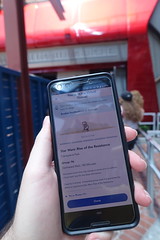 Visiting within the opening week, it was already clear that Avengers Campus was designed for a bygone time that no longer exists; namely a time where the assumption was that passholders and repeat visitors ruled the day at the Disneyland Resort. Hence a land that serves less as an epic backdrop for superhero battles but more as a chill hang-out space to grab a drink or snack, where super heroes stop by for quick unscheduled get-togethers, and where the anchor attraction is primarily based around selling merchandise that enhance the repeat value for people that have already ridden it a dozen times. A reservation system required reflexes measured in the milliseconds to secure a day-of reservation to ride the attraction a maximum once per day as part of a daily ticket value over $100. I can think of no other attraction in the history of theme parks that has had a worse repeat value than that. Annual passes are eliminated, and they’re unlikely to come back in the form they once took. A brave new world, indeed.
Visiting within the opening week, it was already clear that Avengers Campus was designed for a bygone time that no longer exists; namely a time where the assumption was that passholders and repeat visitors ruled the day at the Disneyland Resort. Hence a land that serves less as an epic backdrop for superhero battles but more as a chill hang-out space to grab a drink or snack, where super heroes stop by for quick unscheduled get-togethers, and where the anchor attraction is primarily based around selling merchandise that enhance the repeat value for people that have already ridden it a dozen times. A reservation system required reflexes measured in the milliseconds to secure a day-of reservation to ride the attraction a maximum once per day as part of a daily ticket value over $100. I can think of no other attraction in the history of theme parks that has had a worse repeat value than that. Annual passes are eliminated, and they’re unlikely to come back in the form they once took. A brave new world, indeed.
 Superheroes serve as a form of wish fulfillment for the various struggles of the day; the Marvel films in particular often seem to pride themselves on their timeliness, which of course introduces a challenge for theme parks where timelessness is used as an insurance against costly renovations. The stories are also mostly driven by characters and, moreso, the events that happen around those characters. For a themed environment, that offers both challenges (like how to ground it in a fixed location outside of a specific timeline of events that is still attractive and aspirational) and opportunities (such as taking advantage of the dynamic, high-thrill energy of superhero stories). Avengers Campus seems to have been mostly preoccupied with how to address the challenges, perhaps at the expense of some opportunities. The result is a land that, I earnestly believe, is actually designed with a lot of intelligence and clever ideas that largely succeeds with (most of) the goals it set for itself. The problem is, those are not necessarily the same goals that much of its audience had in mind for what it wanted from an Avengers themed space.
Superheroes serve as a form of wish fulfillment for the various struggles of the day; the Marvel films in particular often seem to pride themselves on their timeliness, which of course introduces a challenge for theme parks where timelessness is used as an insurance against costly renovations. The stories are also mostly driven by characters and, moreso, the events that happen around those characters. For a themed environment, that offers both challenges (like how to ground it in a fixed location outside of a specific timeline of events that is still attractive and aspirational) and opportunities (such as taking advantage of the dynamic, high-thrill energy of superhero stories). Avengers Campus seems to have been mostly preoccupied with how to address the challenges, perhaps at the expense of some opportunities. The result is a land that, I earnestly believe, is actually designed with a lot of intelligence and clever ideas that largely succeeds with (most of) the goals it set for itself. The problem is, those are not necessarily the same goals that much of its audience had in mind for what it wanted from an Avengers themed space.
 Let’s start with the setting. A superhero campus-slash-science expo is actually a decent way to bring a lot of very disparate heroes together in a single space and embrace the contradictions between them while still holding it all together with a somewhat consistent logic. The challenge is, it seems that many fans would be more interested in seeing a fantastical setting from the films, such as Wakanda, Asgard, or Knowhere, and re-create it in detail in a similar model to the Wizarding World of Harry Potter. But there’s big problems with trying to make a land that’s one of (or all of) those places too; problems that, when you work through them all, probably make it an even less attractive option than a campus! For as wildly expensive as that approach is, it’s left with a far more limited selection of characters and a fixed, inflexible art direction that’s established based on a few seconds worth of establishing shots that some CG artists tossed together without ever considering that it might eventually become a physical place. And the reality is, the Marvel films aren’t very location-oriented to begin with.
Let’s start with the setting. A superhero campus-slash-science expo is actually a decent way to bring a lot of very disparate heroes together in a single space and embrace the contradictions between them while still holding it all together with a somewhat consistent logic. The challenge is, it seems that many fans would be more interested in seeing a fantastical setting from the films, such as Wakanda, Asgard, or Knowhere, and re-create it in detail in a similar model to the Wizarding World of Harry Potter. But there’s big problems with trying to make a land that’s one of (or all of) those places too; problems that, when you work through them all, probably make it an even less attractive option than a campus! For as wildly expensive as that approach is, it’s left with a far more limited selection of characters and a fixed, inflexible art direction that’s established based on a few seconds worth of establishing shots that some CG artists tossed together without ever considering that it might eventually become a physical place. And the reality is, the Marvel films aren’t very location-oriented to begin with. When they do show locations, it’s often to emphasize the globe-hopping nature of the narrative, with New York City as one of the more common recurring locations in the films. But who in their right mind makes a New York themed land the cornerstone of a park that’s called “California Adventure”?
When they do show locations, it’s often to emphasize the globe-hopping nature of the narrative, with New York City as one of the more common recurring locations in the films. But who in their right mind makes a New York themed land the cornerstone of a park that’s called “California Adventure”?
So a campus it is. It’s flexible, it can create its own visual sense of identity rooted in the Marvel legacy while also gently acknowledging the geographic location and community that hosts it. Clearly, this is an intelligent solution (or at least a sober one), even if it’s not exactly what fans might have wanted.
 The next major problem is, how to make the land still feel fantastical and not like they just opened “Avengers Campus: Irvine”? Yes, the Web-Slingers show building does bear a more than passing resemblance to a popular 90’s electronics store, but after I had time to explore the campus as a whole, I don’t think enough credit has been given to how much thought was obviously applied to each corner to make it visually interesting and preemptively deflect any “corporate campus” criticisms that it nevertheless received. There’s the street art along the building that everyone passes as they arrive, and the sense of layered history and more roughly textured finishes that was achieved through the backstory that Avengers Campus represents creative reuse of an old Stark Industries Campus… okay, so maybe the gentrified adaptive reuse makes it more “Avengers Campus: L.A. Arts District”? But dig a little deeper, and everything from lighting fixtures to tiling treatments, walkway surfaces to horticultural selections… it’s all consistently very distinctive, and helps to communicate a unique sense of place and identity that makes it a surprisingly vibrant urban setting to explore, even if it doesn’t always meet the most obvious visitor expectations for what they think a Marvel land should look like.
The next major problem is, how to make the land still feel fantastical and not like they just opened “Avengers Campus: Irvine”? Yes, the Web-Slingers show building does bear a more than passing resemblance to a popular 90’s electronics store, but after I had time to explore the campus as a whole, I don’t think enough credit has been given to how much thought was obviously applied to each corner to make it visually interesting and preemptively deflect any “corporate campus” criticisms that it nevertheless received. There’s the street art along the building that everyone passes as they arrive, and the sense of layered history and more roughly textured finishes that was achieved through the backstory that Avengers Campus represents creative reuse of an old Stark Industries Campus… okay, so maybe the gentrified adaptive reuse makes it more “Avengers Campus: L.A. Arts District”? But dig a little deeper, and everything from lighting fixtures to tiling treatments, walkway surfaces to horticultural selections… it’s all consistently very distinctive, and helps to communicate a unique sense of place and identity that makes it a surprisingly vibrant urban setting to explore, even if it doesn’t always meet the most obvious visitor expectations for what they think a Marvel land should look like.
 But a theme park land hinges on its attractions, and right now Avengers Campus is missing its anchor Avengers attraction with no indication when it might arrive. Assuming that it does eventually arrive as the mega-blockbuster experience that everyone expects,1 the other attractions actually seem to represent a fairly thoughtful balance for a well-rounded theme park land. A wild thrill ride, a family interactive ride, and high-impact anchor attraction that everyone will want to ride. Also, the attraction themes are (or will be) well-balanced across the main story types found within the Marvel cinematic universe: Spider-Man brings the tech and youthful energy, Guardians of the Galaxy bring the aliens and
But a theme park land hinges on its attractions, and right now Avengers Campus is missing its anchor Avengers attraction with no indication when it might arrive. Assuming that it does eventually arrive as the mega-blockbuster experience that everyone expects,1 the other attractions actually seem to represent a fairly thoughtful balance for a well-rounded theme park land. A wild thrill ride, a family interactive ride, and high-impact anchor attraction that everyone will want to ride. Also, the attraction themes are (or will be) well-balanced across the main story types found within the Marvel cinematic universe: Spider-Man brings the tech and youthful energy, Guardians of the Galaxy bring the aliens and snarky humor, the Doctor Strange show adds an element of more serious mysticism, while the future E-ticket will bring everyone together for the blockbuster heroism. Having been part of the design process for a different superhero land with multiple character-based attractions (including an anchor “superhero team” ride), I can attest to the challenges faced with making sure that each attraction feels narratively and emotionally distinct from one another while keeping the IP-holders happy. The Marvel films themselves often suffer from being forced to raise the stakes too high for the final smash-em-up sequence, so the fact that the stakes are allowed to remain relatively low for both Web-Slingers and Guardians of the Galaxy at least demonstrates some strategic creative thinking. Of course, without the blockbuster anchor, the attraction mix is decidedly missing a key element that people would rightfully expect from a theme park experience based on the blockbuster superhero movies… namely, getting to experience blockbuster superhero action. Only time will tell when Avengers Campus finally gives the people what they most clearly want from an Avengers ride. Until that time, we’ll just have to look at the existing attractions in isolation.
snarky humor, the Doctor Strange show adds an element of more serious mysticism, while the future E-ticket will bring everyone together for the blockbuster heroism. Having been part of the design process for a different superhero land with multiple character-based attractions (including an anchor “superhero team” ride), I can attest to the challenges faced with making sure that each attraction feels narratively and emotionally distinct from one another while keeping the IP-holders happy. The Marvel films themselves often suffer from being forced to raise the stakes too high for the final smash-em-up sequence, so the fact that the stakes are allowed to remain relatively low for both Web-Slingers and Guardians of the Galaxy at least demonstrates some strategic creative thinking. Of course, without the blockbuster anchor, the attraction mix is decidedly missing a key element that people would rightfully expect from a theme park experience based on the blockbuster superhero movies… namely, getting to experience blockbuster superhero action. Only time will tell when Avengers Campus finally gives the people what they most clearly want from an Avengers ride. Until that time, we’ll just have to look at the existing attractions in isolation.
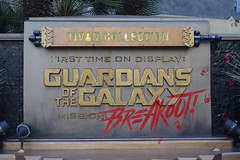 Even though it opened before the rest of Avengers Campus, Guardians of the Galaxy – Mission: BREAKOUT set the stage for a land that’s defined by clever solutions to a problem for which no perfect solution could have existed. Many, including myself, showed up to the rethemed attraction for the first time skeptical of the bric-a-brac exterior that replaced the iconic Hollywood Tower Hotel, seemingly the most visible example of Disney’s increasingly bold diktat for IP integration at all costs, even a quick and dirty ill-fitted re-theme of an already popular attraction that felt at home in its Hollywood setting. However, the attraction also became the largest theme park project located in California to be visibly led by celebrated Imagineer Joe Rohde, and the end result
Even though it opened before the rest of Avengers Campus, Guardians of the Galaxy – Mission: BREAKOUT set the stage for a land that’s defined by clever solutions to a problem for which no perfect solution could have existed. Many, including myself, showed up to the rethemed attraction for the first time skeptical of the bric-a-brac exterior that replaced the iconic Hollywood Tower Hotel, seemingly the most visible example of Disney’s increasingly bold diktat for IP integration at all costs, even a quick and dirty ill-fitted re-theme of an already popular attraction that felt at home in its Hollywood setting. However, the attraction also became the largest theme park project located in California to be visibly led by celebrated Imagineer Joe Rohde, and the end result seemed to confirm Rohde’s talent for leading a team to intelligent and creative problem solving.
seemed to confirm Rohde’s talent for leading a team to intelligent and creative problem solving.
One of my issues with the Tower of Terror rides has been that for a storyline and ride system that seem designed for a suspenseful climatic build-up, the ride is so busy with storytelling that there’s almost no moment to hold that suspense before the thrills kick in and the catharsis is released. Mission: BREAKOUT ups the thrill profile while acknowledging that this ride system was probably better suited for a more high-energy, rock-and-roll kind of experience from the beginning. The pre-show room is now an actual show-show instead of just a television in an atmospheric setting, and the story is reasonably clever in its efficiency, striking an admirable balance of action, humor, and gently embracing the fact that people are at a theme park wanting to have fun on a thrill ride. A simple LED strip mounted above a couple of key locations provides what is possibly the greatest cost-to-impact ratio of a piece of theming on any Disney attraction; at first it provides a goofy bit of interactivity to alert people their experience is about to begin as they’re asked to hold up their hands to be scanned by the LED strip; then it becomes part of the storyline by making visitors part of the escape plot; and finally, the plot pays off by revealing that all along it was just a gambit to get everyone to throw their arms in the air at the moment before takes-off. Most of Disney’s recent show writing has been on a scale of cringe-inducing bad to decently forgettable, so Guardians stands out as the one recent attraction where the writing was worthy of its own nod.
embracing the fact that people are at a theme park wanting to have fun on a thrill ride. A simple LED strip mounted above a couple of key locations provides what is possibly the greatest cost-to-impact ratio of a piece of theming on any Disney attraction; at first it provides a goofy bit of interactivity to alert people their experience is about to begin as they’re asked to hold up their hands to be scanned by the LED strip; then it becomes part of the storyline by making visitors part of the escape plot; and finally, the plot pays off by revealing that all along it was just a gambit to get everyone to throw their arms in the air at the moment before takes-off. Most of Disney’s recent show writing has been on a scale of cringe-inducing bad to decently forgettable, so Guardians stands out as the one recent attraction where the writing was worthy of its own nod.
Unfortunately, there are still two big knocks against Guardians of the Galaxy. First, the two show scenes along the elevator shaft replace the scenic sets and practical illusions with more simplistic (yet still very high-tech) media extensions. While this ostensible downgrade in showmanship is a little disappointing (yet it’s honestly balanced out across the entire attraction when you factor in the pre-show’s transformation from screen-based to full animatronic show), the bigger issue is that now the ride vehicle is synchronizing with media while in motion. Lots of media-based attractions already do that, but not on a vertical axis where riders are simultaneously experiencing full or partial weightlessness, and the combination of media with the more aggressive, start-stop-start ride profile makes Guardians of the Galaxy a decidedly more nauseating experience than its predecessor, at least for me personally. (Mission: Lunch BREAKOUT!)
experiencing full or partial weightlessness, and the combination of media with the more aggressive, start-stop-start ride profile makes Guardians of the Galaxy a decidedly more nauseating experience than its predecessor, at least for me personally. (Mission: Lunch BREAKOUT!)
I also have to go back to critique the exterior facade. During debates about the merits of the Marvel overlay, there were lots of arguments in defence of the change that the Guardians were far better known by today’s audiences than the old Twilight Zone branding, while others countered that Twilight Zone still had relevance, and/or because it was an anthology series you didn’t need to have ever seen the show to still get what the ride was about, just the same as any other “original concept” attraction. This annoyed me because it centered the debate entirely around the concept of intellectual property (or the lack thereof) as the means of setting audience expectations. The problem with this framing is that there’s already a tool in arts and storytelling to set those expectations and establish those pre-existing emotional connections, a tool that predates intellectual property laws, and indeed might still be more universally effective at achieving the goal of presetting expectations than even the most popular IP is capable of.
just the same as any other “original concept” attraction. This annoyed me because it centered the debate entirely around the concept of intellectual property (or the lack thereof) as the means of setting audience expectations. The problem with this framing is that there’s already a tool in arts and storytelling to set those expectations and establish those pre-existing emotional connections, a tool that predates intellectual property laws, and indeed might still be more universally effective at achieving the goal of presetting expectations than even the most popular IP is capable of.
It’s called genre.
 Tower of Terror was successful because it used genre, specifically horror and sci-fi genres, in a very clear, intentional manner. One need only look at the scarred, crackling Hollywood Tower Hotel facade for a couple of seconds to understand what genres the attraction operates in and establish the emotional connection from those pre-established genre associations. Look at the colorful clutter of the Guardians of the Galaxy facade, and while it might hint at the specific IP attached to it, it also tells you very little about what genre the attraction is operating in. Sci-fi? Action? Comedy?2 There’s nothing about it that forms a quick mental connection to any of those genres,3 and even if you know it has the connection
Tower of Terror was successful because it used genre, specifically horror and sci-fi genres, in a very clear, intentional manner. One need only look at the scarred, crackling Hollywood Tower Hotel facade for a couple of seconds to understand what genres the attraction operates in and establish the emotional connection from those pre-established genre associations. Look at the colorful clutter of the Guardians of the Galaxy facade, and while it might hint at the specific IP attached to it, it also tells you very little about what genre the attraction is operating in. Sci-fi? Action? Comedy?2 There’s nothing about it that forms a quick mental connection to any of those genres,3 and even if you know it has the connection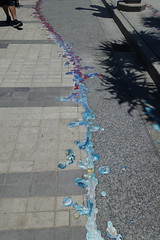 to the popular Marvel characters, that’s more of an intellectual association than a gut emotional one. The Guardians wanted to be seen as iconoclasts and the Imagineers embraced that in the design, so it’s little surprise that it takes a while longer until people get inside the attraction that many start to warm up to its individualistic style.
to the popular Marvel characters, that’s more of an intellectual association than a gut emotional one. The Guardians wanted to be seen as iconoclasts and the Imagineers embraced that in the design, so it’s little surprise that it takes a while longer until people get inside the attraction that many start to warm up to its individualistic style.
It also doesn’t help that, even when it was finally included in the rest of Avengers Campus, the massive ride building still doesn’t make any sense with its surroundings. The Avengers Headquarters facade with a Quinjet atop is meant to be the Campus’ “weenie” (visual icon) to draw people into the land, but the scale is still dwarfed by the Guardians tower looming immediately behind it as the biggest, most eye-catching photo-bomb to ever take place in a Disney theme park. The only thing that tries to tie the space hotel into the rest of the campus is a colorful “Kirby krackle” sprinkled along the pavement in front of the attraction, a novel callback to the comic book art used to signify a disruption in space-time that, once again, demonstrates the land’s propensity to smart solutions that nevertheless might still be too clever by half for its audience.
 The live shows and character interactions that dot the land do a lot of the heavy-lifting in terms of meeting visitor expectations for an Avengers Campus… namely, the opportunity to meet an Avenger and see them in action. A Black Widow show atop the Avengers Headquarters is, at present, the only place in Avengers Campus where you can see the heroes in combat against a villain character. This allows the rest of the shows to branch out into different formats, again defying some expectations around “seeing Marvel characters in action,” even if it was definitely the smart thing to do. Sometimes it’s to great effect, such as the Dora Milaje asking for a moment of silence for all of the kings and queens who have left before us, an unexpectedly touching moment of sincerit
The live shows and character interactions that dot the land do a lot of the heavy-lifting in terms of meeting visitor expectations for an Avengers Campus… namely, the opportunity to meet an Avenger and see them in action. A Black Widow show atop the Avengers Headquarters is, at present, the only place in Avengers Campus where you can see the heroes in combat against a villain character. This allows the rest of the shows to branch out into different formats, again defying some expectations around “seeing Marvel characters in action,” even if it was definitely the smart thing to do. Sometimes it’s to great effect, such as the Dora Milaje asking for a moment of silence for all of the kings and queens who have left before us, an unexpectedly touching moment of sincerit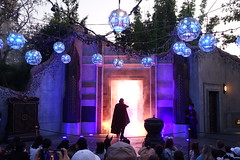 y following a year of loss, including of Black Panther star Chadwick Boseman.
y following a year of loss, including of Black Panther star Chadwick Boseman.
Others could still use a bit of work to achieve their full potential. With its own uniquely detailed corner, the Doctor Strange show in the Ancient Sanctum seemed positioned as Avengers Campus’ stealth third attraction, one that might be worth queuing up to an hour to catch a performance, as I did opening week. In reality, while the capacity is restricted to provide a closer, more intimate experience, the show isn’t necessarily more of a “must see” than any other superheroic performances throughout the campus. Its collection of magic trick standards mixed with self-serious mystical jargon is a quaintly old-school approach to interpret a franchise in which “magic” mainly equates to bombastic CG effects.
to interpret a franchise in which “magic” mainly equates to bombastic CG effects.
Another performance that doesn’t quite stick the landing is the Spider-Man rooftop show with the much-lauded “Stuntronic” performer flung high through the air. The constraints of the stunt clearly require a lot of careful staging and scripting to make it work as the show’s centerpiece, yet the comic tone (which, again, is totally in keeping with the spirit of Spider-Man) finds itself somewhat at odds with the expectation that such a high-profile stunt should carry a bit more dramatic oomph, and much of the comic relief preceding it comes off more as needless vamping.
Which brings me to Web-Slingers: A Spider-Man Adventure. There were a lot of expectations riding on this interactive dark ride to represent all the heroics that a Marvel hero could, when in fact it was clear that the ride very deliberately only wanted to represent a friendly neighborhood Spider-Man. Much like the MCU’s version of Peter Parker, which eliminated the character’s sense of trauma and existential responsibility in favor of a more affirmative character arc about finding one’s place in the world while having fun,4 Web-Slingers is also very intentional about lowering the stakes.
While the ride at Universal I’ve criticized in the past for being overloaded with too many villains, Web-Slingers boldly takes the opposite tact by featuring essentially no villains.5 Instead, we get the Spider-Bots, friendly neighborhood do-good bots dreamed up by a team of high schoolers where, despite the obvious yet unmentioned military applications, primarily seem designed to juice toy sales at the nearby WEB Suppliers (even moreso than a similar interactive attraction at the same park that is literally based around toys). Despite the obvious global threat self-replicating robots could cause, the stakes are curiously but perhaps tellingly limited to “the destruction of Avengers Campus.” No need to call Mr. Stark or the other Avengers if the world itself isn’t in jeopardy; save that for the actual (yet still imaginary) Avengers attraction.
being overloaded with too many villains, Web-Slingers boldly takes the opposite tact by featuring essentially no villains.5 Instead, we get the Spider-Bots, friendly neighborhood do-good bots dreamed up by a team of high schoolers where, despite the obvious yet unmentioned military applications, primarily seem designed to juice toy sales at the nearby WEB Suppliers (even moreso than a similar interactive attraction at the same park that is literally based around toys). Despite the obvious global threat self-replicating robots could cause, the stakes are curiously but perhaps tellingly limited to “the destruction of Avengers Campus.” No need to call Mr. Stark or the other Avengers if the world itself isn’t in jeopardy; save that for the actual (yet still imaginary) Avengers attraction.
If there is one comparison to make to the Universal Spider-Man, it’s that the stories for both attractions mostly revolve around a forced procession of scenes designed to give each item in a series of four its moment in the spotlight before moving on to the next one. At Universal it’s the villains, and at Avengers Campus it’s… the other attractions at Avenger’s Campus. Pym Test Kitchen, Guardians of the Galaxy, and even the unbuilt Avengers mega-attraction all get their own “featured” scene.6
it’s that the stories for both attractions mostly revolve around a forced procession of scenes designed to give each item in a series of four its moment in the spotlight before moving on to the next one. At Universal it’s the villains, and at Avengers Campus it’s… the other attractions at Avenger’s Campus. Pym Test Kitchen, Guardians of the Galaxy, and even the unbuilt Avengers mega-attraction all get their own “featured” scene.6
It’s an odd way to try to integrate a land that by its nature is made up of disparate parts. It feels like the intent was to find a clever way to both tie the land and attractions together into one storyline and also make the ride self-referential and thus “clever” or even “irreverent”—just like Spider-Man! But instead it feels like an awkward character crossover special, sans any of the other characters. It’s a form of storytelling that relies on predictable, formulated beats, and not even a storytelling formula, but a formula devised for organizing a theme park masterplan. It’s easier to pitch as a clever concept than to actually prove that it is still clever by the final draft of the script.
or even “irreverent”—just like Spider-Man! But instead it feels like an awkward character crossover special, sans any of the other characters. It’s a form of storytelling that relies on predictable, formulated beats, and not even a storytelling formula, but a formula devised for organizing a theme park masterplan. It’s easier to pitch as a clever concept than to actually prove that it is still clever by the final draft of the script.
Instead, much of the ride’s charms come down to making hidden discoveries, whether it’s an interactive gameplay gesture7 that yields a surprising result, or one of many Easter eggs hidden within the sets. This is a ride of small heroes and minor victories, which is both refreshing in an era of excess in our entertainment, but also frustrating in its inability to dream bigger. Indeed, the same can be extrapolated to the design of Avengers Campus writ large. Against the looming forces of synergizing and merchandising, the land lacks the heroism of bold creative leadership guided by a clear vision, and instead distributes decisions to a team of talented but relatively powerless individuals. So much of what’s interesting or ambitious is found in details rather than the bigger picture, because that’s the level to which any independent creativity is allowed to happen before those bigger forces need to get involved.
which is both refreshing in an era of excess in our entertainment, but also frustrating in its inability to dream bigger. Indeed, the same can be extrapolated to the design of Avengers Campus writ large. Against the looming forces of synergizing and merchandising, the land lacks the heroism of bold creative leadership guided by a clear vision, and instead distributes decisions to a team of talented but relatively powerless individuals. So much of what’s interesting or ambitious is found in details rather than the bigger picture, because that’s the level to which any independent creativity is allowed to happen before those bigger forces need to get involved.
 Over and over again in this land, there are smart solutions to small problems, and big problems that have no solution that can be solved simply through smart design. The MCU currently has 30 different superheroes across 25 films that need to be fairly represented within a four acre plot of land featuring only three full-sized attractions—two of which had to be reskins or at least fit within an existing show building, and the third of which won’t even start construction for years after the rest of the land. Designing that densely for a franchise inside a park this popular means that capacity limits, bottlenecks, and even seating and shading were always going to be problems no matter what.
Over and over again in this land, there are smart solutions to small problems, and big problems that have no solution that can be solved simply through smart design. The MCU currently has 30 different superheroes across 25 films that need to be fairly represented within a four acre plot of land featuring only three full-sized attractions—two of which had to be reskins or at least fit within an existing show building, and the third of which won’t even start construction for years after the rest of the land. Designing that densely for a franchise inside a park this popular means that capacity limits, bottlenecks, and even seating and shading were always going to be problems no matter what.
Of course, there are ways in which design could be improved. But, it’s not always possible for design to solve every problem, just as it’s not always possible for superheroes to save the world. Even the Avengers, for all their power and talent, have proven that they mostly just want to defend and restore the status quo. If we ever get to be superheroes, as places like Avengers Campus insist we can become, then please try to have a little more imagination for what a better world could look like.

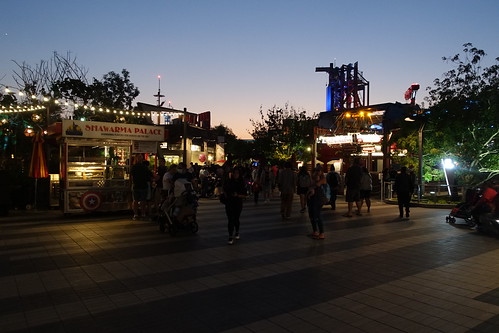








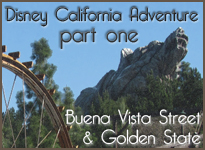
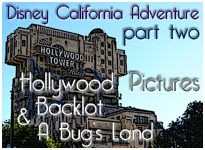
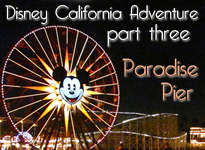
Footnotes & Annotations
[1] I’m more optimistic than some that this attraction will eventually see the light of day in a format not too far removed from the original ambitious plans. The entry facade is already built suggesting development was fairly far along and would be both costly and time-consuming to reverse course for a different plan now. Plus, despite the delays and period of uncertainty from COVID, with all signs pointing ahead to a rebounding economy while interest rates are still low, I see little incentive for the very brand-oriented leadership to future forecast the need to pinch pennies around what is by far their biggest franchise. Of course, not that they won’t pinch a lot of pennies elsewhere.
[2] And that’s not even counting the Halloween seasonal “Monsters After Dark” overlay that also throws the horror genre back into the mix.
[3] Sci-fi comes closest, but the bright colors paired with industrial textures doesn’t easily match existing archetypes.
[4] And “finding one’s place in the world” for the MCU really means “deciding whether to join an extrajudicial police force controlling unfathomably powerful weaponry to enforce global order.” A decision that any teen could relate to.
[5] Just look at the names for a comparison of the two different philosophies. Universal goes for the definite article and plural form for its adventures (and amazing ones too, no less!), while Disney’s ride gets the indefinite singular treatment.
[6] And unlike Universal’s Amazing Adventure of Spider-Man, which includes some good introductory and finale scenes bookending the villain Rolodex sequence, Web-Slingers consists almost exclusively of those four scenes.
[7] The gesture-based interactivity was both more fun and fluid in functionality than I might have expected, although to be certain I didn’t feel very much like Spider-Man as I did a wildly gesticulating Italian in an argument with the Spider-Bots.